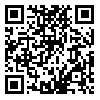Volume 14, Issue 3 (May & Jun 2024)
J Research Health 2024, 14(3): 269-276 |
Back to browse issues page
Download citation:
BibTeX | RIS | EndNote | Medlars | ProCite | Reference Manager | RefWorks
Send citation to:



BibTeX | RIS | EndNote | Medlars | ProCite | Reference Manager | RefWorks
Send citation to:
Javdan M, AhmadiTeifakani B, Samavi A. Adolescent Self-harm Behavior Based on Depression, Family Emotional Climate, School Identity, and Academic Performance. J Research Health 2024; 14 (3) :269-276
URL: http://jrh.gmu.ac.ir/article-1-2371-en.html
URL: http://jrh.gmu.ac.ir/article-1-2371-en.html
1- Department of Counseling and Psychology, School of Humanities, University of Hormozgan, Bandar Abbas, Iran. , javdan@hormozgan.ac.ir
2- Department of General Psychology, School of Humanities, University of Hormozgan, Bandar Abbas, Iran.
3- Department of Educational Sciences, School of Humanities, University of Hormozgan, Bandar Abbas, Iran.
2- Department of General Psychology, School of Humanities, University of Hormozgan, Bandar Abbas, Iran.
3- Department of Educational Sciences, School of Humanities, University of Hormozgan, Bandar Abbas, Iran.
Abstract: (3681 Views)
Background: This study investigated factors affecting self-harming behaviors and preventing self-harming thoughts and behavior in adolescent girls. Physical, cognitive, and socioemotional changes accompany adolescence. The family and school must support the adolescent in this regard.
Methods: The research is a correlational study, and data collection was through the census method. All 150 girls aged between 12 and 24 years who lived in one of the villages (Benoband) of Bandar Abbas City, Iran, in 2022 were recruited. The deliberate self-harm inventory (Gratz, 2001), the Kutcher adolescent depression scale, the dual school climate, and school identification measure-student, the academic performance questionnaire (Pham & Taylor, 1999), and the affective family climate were used for data collection. The collected data were analyzed using multiple linear regression analysis in SPSS software, version 26.
Results: The results revealed that depression has a direct relationship with self-harm (0.30), the emotional atmosphere of the family (-0.49), and school climate and identity (-0.49). Also, the academic performance had a significant negative relationship (-0.47) with self-harm (P<0.001). Regression analysis showed that these variables can explain 39% of the variance of adolescent self-harm behavior (F=25.16, P≤0.001).
Conclusion: The research showed that teenagers need education and awareness in schools and families. Also, parents’ education to familiarize them with the particular characteristics of adolescents, including their emotional and social characteristics, will lead to a greater understanding of the adolescent in the family and mental and psychological peace of the adolescents. A comprehensive health education program should include coping skills, interpersonal communication, goal setting, anger management, and advocacy skills.
Methods: The research is a correlational study, and data collection was through the census method. All 150 girls aged between 12 and 24 years who lived in one of the villages (Benoband) of Bandar Abbas City, Iran, in 2022 were recruited. The deliberate self-harm inventory (Gratz, 2001), the Kutcher adolescent depression scale, the dual school climate, and school identification measure-student, the academic performance questionnaire (Pham & Taylor, 1999), and the affective family climate were used for data collection. The collected data were analyzed using multiple linear regression analysis in SPSS software, version 26.
Results: The results revealed that depression has a direct relationship with self-harm (0.30), the emotional atmosphere of the family (-0.49), and school climate and identity (-0.49). Also, the academic performance had a significant negative relationship (-0.47) with self-harm (P<0.001). Regression analysis showed that these variables can explain 39% of the variance of adolescent self-harm behavior (F=25.16, P≤0.001).
Conclusion: The research showed that teenagers need education and awareness in schools and families. Also, parents’ education to familiarize them with the particular characteristics of adolescents, including their emotional and social characteristics, will lead to a greater understanding of the adolescent in the family and mental and psychological peace of the adolescents. A comprehensive health education program should include coping skills, interpersonal communication, goal setting, anger management, and advocacy skills.
Type of Study: Orginal Article |
Subject:
● Psychosocial Health
Received: 2023/06/18 | Accepted: 2023/09/5 | Published: 2024/05/1
Received: 2023/06/18 | Accepted: 2023/09/5 | Published: 2024/05/1
| Rights and permissions | |
 |
This work is licensed under a Creative Commons Attribution-NonCommercial 4.0 International License. |









